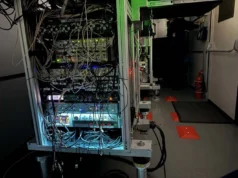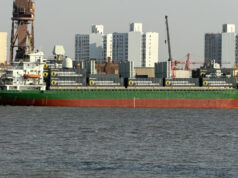Harland & Wolff Appledore will return a former Royal Navy minehunter to operational service for the Lithuanian Navy.
Back in 2020, Appledore Shipyard in south-west England which built its last ship for the Irish Naval Service reopened after the previous owners went out of business. The historic shipyard as previously reported, had been acquired by Infrastrata, the owners of Belfast shipyard Harland and Wolff. The shipyard was renamed H&W Appledore.
The description of the contract award states:
“Repair and maintenance services of security and defence materials. The Lithuanian Navy is looking to expand its fleet of Hunt Class Mine Counter Measures Vessel (MCMV) via procurement of a legacy hull from the Royal Navy and regeneration of said hull to an agreed operational state, closely aligned to the Lithuanian Skalvis Class vessels currently in service with the LTU Navy.
The scope of this project is for a single entity to deliver the regenerated vessel, with stated mission and sonar systems to an agreed operational condition. Prior to award of the contract, ownership of the vessel will pass to LTU.
DESA is the contracting authority that will procure and enter into the contract. Immediately upon signature, the contract shall be novated to the Lithuanian Ministry of National Defence (LTU Defence Materiel Agency). From this point, LTU MND will become the contracting authority.”
According to a Ministry of Defence press release.
“On behalf of the Lithuanian Government, the Defence Equipment Sales Authority (DESA) awarded the contract that will see HMS QUORN renovated and restored, bolstering NATO maritime capability in Europe. Supporting ambitions to bolster British shipbuilding, laid out in the National Shipbuilding Strategy Refresh, the regeneration will support 100 jobs at the south-west shipyard. The work will see an influx of contractors for the project across the local and national supply chain, with 14 major subcontract packages in engineering, equipment and integration, along with other refurbishment services.”
Minister for Defence Procurement, Jeremy Quin, said:
“I’m pleased that this multi-million pound contract will see a former Royal Navy mine-hunting vessel restored and regenerated in a British shipyard, supporting UK jobs and strengthening shipbuilding in the south-west.Lithuania is a key NATO ally and Joint Expeditionary Force partner, and this mine-hunting vessel will bolster NATO maritime capability across Europe, ensuring the Alliance remains ready to respond to evolving global threats.”
According to the contract notice, the contract is worth £110m in total, which is twice the headline figure provided by the Ministry of Defence. I can only assume this is the total potential value of the contract and £55m is the initial spend.













Who is paying for this refit? MOD/ DESA or Lithuania? The Baltic states need to massively ramp up defence expenditure and the UK shouldnt be spending tax payers money refurbishing a mine hunter on their behalf whilst simultaneously cutting the RN due to defence cuts. This is especially so as the UK are having to contribute army battle groups and RAF fighters to their defence.
Isn’t helping out NATO’s eastern flank worth it? If they fall to an invasion it leads to access to the rest of continental Europe very quickly.
Agreed Tom. Lithunia looks to have a nice little balanced fleet up on the Eastern Flank. I’d rather these were doing their job up where the potential action is. Even if we are paying for it (which i don’t think is the case) is it much different than sending over NLAWs, M270’s or ammunition from our stocks? Strategic defence in depth.
Also as a native of South West England im delighted that Appledore are going to be back in the game 😀
Of course you are absolutely correct.
Did you read the text about the Lithuanian government becoming the contracting party by novation immediately after signature. Also ” on behalf of the Lithuanian government “
Lithuania is paying, it’s their ship. It’s one of the important points often over looked in the ship building debate is that ship servicing and repair is often higher value and their is much less competition in it. Anyone can knock lumps of metal together, few can repair advanced sonar. At £55 million that’s the benefit to the economy of a high end OPV.
On the contrary, knocking large lumps of metal together is a much bigger and complex job, as it also involves installing the expensive kit once the steel is put together.
They all spend 2% which is more than Germany and if rumour control is to be believed, will be more than us.
Now, 2% of not very much, is very little… however, they have a rare substance that we lack: manpower.
So, with your question who pays, I expect the Lithuanians do; with regard to ramping up expenditure, I disagree.
However, if I were to gift them anything it would be an AAW/ASW, fitted for T31. That would gift the Balts a mobile AA system.
They bought the ship for £1m and are spending £55m on refurbing it.
H&W Appledore also bought another of the class from the MOD for parts.
Good luck to Appledore and H&W with this refit of HMS Quorn. One can only hope that the MoD and DESA leave well alone and let the yard prove itself.
I would like to see the Belfast H&W yard get some of the FSS work, at least one of the ships. In it’s entireity
Still seems an extensive site, despite rundown, other uses. Would just seem crazy not to redevelop, what with the way the world’s … yes, we know….!
Better start soon, though.
Great to see Quorn being refitted etc. I was the first Weapons Engineering Officer on her, joining her in build at Vosper Thornycroft in Woolston, Southampton in 1987. Memories……
It is nice to hear that Appledore is getting some work.
There’s a strong chance Penny Morduant could be our next PM.
I can reference my own mother, con, who would never vote for a person of colour.
However, in this case having someone who served RNR would be no bad thing.
Anybody able to shine a light on that round thing underneath the bridge.
The item of equipment on the front of the bridge screen is a spare GRP Dome, ready for fitting on the hull over the Sonar 2193 Directing Gear transducers. Sonar 2193 is used for minehunting operations.
Also, further to my last, when the Directing Gear is fully retracted the GRP may be removed from the hull for storage and maintenance. A flatter blanking cover is then able to be fitted on the hull providing additional protection of the transducers, for example during dry docking etc.
Many thanks
Could you explain why a sonar on a minehunter can not be used to detect opfor submarines?
Without going into too much detail and bearing in mind sonar detecting parameters are classified, minehunting sonars have much shorter range capability and limited frequency ranges.
Active sonar tuned for picking up small objects at short distance not passively listening for large objects at great distance.
If you flip the broadcast ranges in the following analogy the Minesweeper is using LW Radio and a ship hunter is listening for a TV broadcast.
Actually I guess you could just say the shiphunter is using LW radio and the minehunter is using FM radio.
Thanks so much for the analogy. Paldies.
Historic shipyard?
Seems an awful lot of money for just an over-haul. These ships are ancient.
So a company with no experience of working and overhauling GRP hulled, non-magnetic MCM Vessels got the contract…
This is nothing like refitting a steel hulled vessel.
The magnetic hygiene requirements alone are immense. You need to be careful with steel scaffold(use ally …its easier but more expensive) , magnetic surveys, electrical cables , storage of materials, transporting materials. They all have specific requirements to stop magnetic contamination and induction into materials.
it goes as far as not storing items close to cables , using wooden shelving, no battery powered transport, storing items in a particular way to avoid the earth’s magnetic field inducing magnetism.
Its not something you just do from day one Mess it up and it rapidly becomes an expensive and time-consuming evolution to get back on track
Hi GB,
I wondered about the GRP part of your post, but I think the biggest risk might actually be the magnetic contamination issue as that is invisible. At leats with the GRP there is the possibility of there being something to see.
Hopefully, some of that ‘supplychain’ includes suitably experienced consultants who can provide the necessary technical input. If not then H&W Appledore may be heading into troubled waters. I hope not, as I would really like to see Appledore stay open.
Cheers CR